The definition of "planet" has been the subject of intense debate in recent years. Although the word itself dates back millennia, there was no official scientific definition of a "planet" until the early 21st century.
Traditionally, the term was only applied to objects in the Solar System, and any differences there could be dealt with on an individual basis. After 1992, however, astronomers began to discover many additional objects beyond the orbit of Neptune, as well as hundreds of objects orbiting other stars. These discoveries not only increased the number of potential planets, but also expanded their variety and peculiarity. Some are nearly large enough to be stars, while others are smaller than our Moon, and they have challenged long perceived notions of what a planet could be.
The issue of a clear definition for "planet" came to a head in 2005 with the discovery of the trans-Neptunian object Eris, a body larger than the smallest accepted planet, Pluto. In response, the International Astronomical Union (IAU), recognised by astronomers as the international body responsible for resolving issues of astronomical nomenclature, released its decision on the matter. This definition, which applies only to the Solar System, states that a planet is a body that orbits the Sun, is large enough for its own gravity to make it round, and has "cleared its neighbourhood" of smaller objects.
Pluto does not qualify as a planet under this definition, and the Solar System is thus considered to have eight planets: Mercury, Venus, Earth, Mars, Jupiter, Saturn, Uranus, and Neptune. The new category of dwarf planet was created, currently including Pluto, Eris, and Ceres. The IAU's decision has not resolved all controversies, however, and some in the astronomical community have rejected it outright. The issue of what constitutes a planet will likely remain contentious at least until later this year, when the IAU holds its next Congress in Rio de Janeiro.[1]
History[]
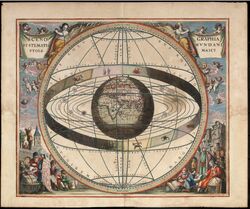
The planets as understood before the acceptance of the heliocentric model.
The word "planet" has meant many things in its long life, some of them contradictory. When originally coined by the ancient Greeks, a planet was any object that appeared to wander against the field of fixed stars that made up the night sky (asteres planetai "wandering stars"). This included not only the five "classical" planets, that is, Mercury, Venus, Mars, Jupiter and Saturn, but also the Sun and the Moon (the "seven heavenly objects"). However, a distinction was occasionally made in terminology; the "five planets" (excluding the Sun and the Moon) were referred to alongside the "seven planets" (including the Sun and the Moon), so that the term "planet", even at this early stage, had acquired ambiguity.
Eventually, when the heliocentric model was accepted over the geocentric, Earth was placed among their number and the Sun was dropped, and after Galileo discovered his four satellites of Jupiter, the Moon was also eventually reclassified. However, the Galilean satellites of Jupiter (in 1610), Saturn's satellite Titan in 1659, and Iapetus and Rhea in 1673 were initially described as "planets", not "moons"; the word "moon" at that time only referred to Earth's Moon.
In 1781, the astronomer William Herschel was searching the sky for binary stars when he observed what he termed a comet in the constellation of Taurus. That this strange object might have been a planet simply did not occur to him; the five planets beyond Earth had been part of humanity's conception of the universe since antiquity. However, unlike a comet, this object's orbit was nearly circular and within the ecliptic plane. Eventually it was recognised as the seventh planet and named Uranus.[2]
Gravitationally induced irregularities in Uranus's observed orbit led eventually to the discovery of Neptune in 1846, and calculation errors that were thought to be irregularities in Neptune's orbit led to the search which ultimately located Pluto in 1930. Pluto was later discovered to be too small to have caused those irregularities, which Voyager 2 determined were due to an overestimation of Neptune's mass.[3]
Pluto rendered obsolete such prior considerations as roughly circular orbit, orbit-perturbing mass, and lying within the ecliptic, as none of them applied to it. Astronomers had therefore to look elsewhere for a definition.
Minor planets[]
One of the unexpected results of William Herschel's discovery of Uranus was that it appeared to validate Bode's law, a mathematical function which generates the size of the semimajor axis of planetary orbits. Astronomers had considered the Law a meaningless coincidence, but Uranus fell at very nearly the exact distance it predicted. Since Bode's Law also predicted a body between Mars and Jupiter that at that point had not been observed, astronomers turned their attention to that region in the hope that it might be vindicated again. Finally, in 1801, astronomer Giuseppe Piazzi found a miniature new world, Ceres, lying at just the correct point in space. The object was hailed as a new planet.[4]
Then in 1802, Heinrich Olbers discovered Pallas, a second "planet" at roughly the same distance from the Sun as Ceres. The idea that two planets could occupy the same orbit was an affront to centuries of thinking. Some years later, another world, Juno, was discovered in a similar orbit. Over the following decades, several more were discovered, all within relatively the same orbital distance.[4]
Herschel suggested that these worlds be given their own separate classification, asteroids (meaning "starlike" since they were too small for their disks to resolve and thus resembled stars), though most astronomers preferred to refer to them as planets. Science textbooks in 1828, after Herschel's death, still numbered the asteroids among the planets. By 1851, the number of asteroids had increased to 15, and a new method of classifying them, by adding a number before their names, was adopted, inadvertently placing them in their own distinct category. By the 1860s, observatories in Europe and the United States began referring to them as "minor planets", or "small planets", though it took the first four asteroids longer to be grouped as such.[4]
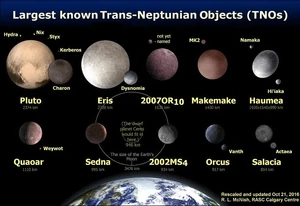
The relative sizes of the largest trans-Neptunian objects as compared to Earth.
The long road from planethood to reconsideration undergone by Ceres is mirrored in the story of Pluto, which was named a planet soon after its discovery in 1930. Pluto was an anomaly: a tiny, icy world in a region of gas giants with an orbit that carried it high above the plane of the ecliptic and even inside that of Neptune. However, it was, as far as anyone could tell, unique. Then, beginning in 1992, astronomers began to detect large numbers of icy bodies beyond the orbit of Neptune that were similar in composition and size to Pluto. They concluded that they had discovered the long-hypothesised Kuiper Belt (sometimes called the Edgeworth-Kuiper Belt), a band of icy debris that is the source for "short-period" comets—those, like Halley, with orbital periods of up to 200 years.[5]
Pluto's orbit lay right in the middle of this band and thus its planetary status was thrown into question; the precedent set by Ceres in downgrading an object from planet status because of a shared orbit led many to conclude that Pluto must be reclassified as a minor planet as well. Mike Brown of the California Institute of Technology suggested that a "planet" should be redefined as "any body in the solar system that is more massive than the total mass of all of the other bodies in a similar orbit."[6] The eight planets over that mass limit would be referred to as "major planets". There was outcry at the prospect of Pluto's "demotion", and in 1999 the International Astronomical Union clarified that it was not at that time proposing to change Pluto's status as a planet.[7][8]
The discovery of several other trans-Neptunian objects approaching the size of Pluto, such as Quaoar and Sedna, continued to erode arguments that Pluto was exceptional from the rest of the trans-Neptunian population. On July 29, 2005, Mike Brown and his team announced the discovery of an object confirmed to be larger than Pluto,[9] named Eris.[10]
Although its discoverers (and many in the news media) immediately referred to it as the tenth planet, it is officially designated as a dwarf planet - although the Minor Planet Center has given it a full minor planet designation: 136199 Eris.
IAU debate[]
- Main article: 2006 redefinition of planet
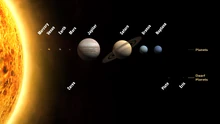
The eight Planets and three Dwarf Planets of the Solar System. (Sizes to scale.)
The discovery of Eris forced the IAU to act on a definition. In October 2005, a group of 19 IAU members, which had already been working on a definition since the discovery of Sedna in 2003, narrowed their choices to a shortlist of three, using approval voting. The definitions were:
- A planet is any object in orbit around the Sun with a diameter greater than 2000 km. (eleven votes in favour)
- A planet is any object in orbit around the Sun whose shape is stable due to its own gravity. (eight votes in favour)
- A planet is any object in orbit around the Sun that is dominant in its immediate neighborhood. (six votes in favour)[11][12]
Since no overall consensus could be reached, the committee decided to put these three definitions to a wider vote at the IAU General Assembly meeting in Prague in August 2006,[13] and on August 24, the IAU put a final draft to a vote, which combined elements from two of the three proposals. It essentially created a medial classification between "planet" and "rock" (or, in the new parlance, "small solar system body"), called "dwarf planet" and placed Pluto among them.[14][15] The vote was passed, though only 424 astronomers took part in the ballot.
| “ | The IAU therefore resolves that planets and other bodies in our Solar System, except satellites, be defined into three distinct categories in the following way:
(1) A "planet"1 is a celestial body that: (a) is in orbit around the Sun, (b) has sufficient mass for its self-gravity to overcome rigid body forces so that it assumes a hydrostatic equilibrium (nearly round) shape, and (c) has cleared the neighbourhood around its orbit. (2) A "dwarf planet" is a celestial body that: (a) is in orbit around the Sun, (b) has sufficient mass for its self-gravity to overcome rigid body forces so that it assumes a hydrostatic equilibrium (nearly round) shape2, (c) has not cleared the neighbourhood around its orbit, and (d) is not a satellite. (3) All other objects3 except satellites orbiting the Sun shall be referred to collectively as "Small Solar System Bodies". Footnotes: 1 The eight planets are: Mercury, Venus, Earth, Mars, Jupiter, Saturn, Uranus, and Neptune. The IAU further resolves: Pluto is a "dwarf planet" by the above definition and is recognized as the prototype of a new category of trans-Neptunian objects. |
” |
Ongoing controversies[]
Despite the IAU's declaration, a number of issues continue to be unresolved. The definition is seen by many as arbitrary and confusing, and a number of Pluto-as-planet proponents, in particular Alan Stern, head of NASA's New Horizons mission to Pluto, have circulated a petition among astronomers to alter the definition. The claim is that, since less than 5 percent of astronomers voted for it, the decision was not representative of the entire astronomical community.[16] Even with this controversy excluded, there remain several ambiguities in the definition.
Clearing the neighborhood[]
- Main article: Clearing the neighborhood
One of the main points at issue is the precise meaning of "cleared the neighborhood around its orbit". Alan Stern recently objected that "it is impossible and contrived to put a dividing line between dwarf planets and planets," and that since neither Earth, Mars, Jupiter, nor Neptune have entirely cleared their regions of debris, none could properly be considered planets under the IAU definition.[17] This would appear to contradict his earlier published work, in which he wrote, "we define an überplanet as a planetary body in orbit around a star that is dynamically important enough to have cleared its neighboring planetesimals ... And we define an unterplanet as one that has not been able to do so," and then a few paragraphs later, "our solar system clearly contains 8 überplanets and a far larger number of unterplanets, the largest of which are Pluto and Ceres."[18]
In his article on the subject, Steven Soter gives one possible explanation. Essentially, "clearing the neighborhood" is Mike Brown's definition by mass dominance: if an orbiting body is more than a hundred times more massive than the remaining collective mass in its "orbital zone", then it is a planet. Two bodies can be said to occupy the same "orbital zone" if their orbits cross a common distance from the star, or "primary", and their orbital periods differ less than an order of magnitude. In other words, if two bodies occupy the same distance from a star at one point in their orbits, and those orbits are similar, rather than, as a comet's would be, extending for several times the other's distance, then they are in the same orbital zone.[19]
Assuming this definition of "neighborhood" is the one ultimately accepted by the IAU, it is still an ambiguous concept. Mark Sykes, director of the Planetary Science Institute in Tucson, Arizona and organiser of the petition, explained the ambiguity to National Public Radio. Since the definition does not categorise a planet by composition or formation, but, effectively, by its location, a Mars-sized or larger object beyond the orbit of Pluto would be considered a dwarf planet, since it would not have time to clear its orbit and would therefore be surrounded by objects of similar mass, whereas an object smaller than Pluto orbiting in isolation would be considered a planet.[20]
Hydrostatic equilibrium[]
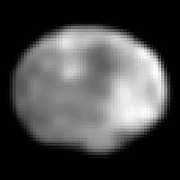
The asteroid Vesta illustrates the broad boundary between "irregular" & "spheroid".
The IAU's definition mandates that planets be large enough for their own gravity to form them into a state of hydrostatic equilibrium; this means that they will reach a shape that is, if not spherical, then spheroidal. This distinction, as opposed to strict sphericity, is mandated by the fact that many large objects in the Solar System, such the planets Jupiter and Saturn, the moons Mimas, Enceladus and Miranda, and the Kuiper belt object 2003 EL61,[21] have been distorted into oblate or prolate spheroids by rapid rotation or tidal forces. However, deciding which objects in the solar system are spheroid is more complicated than it seems. In mathematical terms, spheroids consist of an ellipse rotated around one axis. Consequently they have two axes of equal length and one that is either longer or shorter; they resemble spheres that have been deformed (by stretching or squashing) in one dimension. A section through one axis will produce a circle, and a section through the other two axes will produce an ellipse.[22]
All spheroids, however, have the points on their surfaces joined by smooth curves (which form the elliptical or circular sections). On a topographically irregular body this can only be an approximation; however, taking such irregularity into account, a definite contrast exists between bodies, such as Enceladus, which are essentially spheroidal, and irregular bodies, like Neptune's moon Proteus, whose limbs do not show smooth curvature.[23]
If one uses this mathematical basis to define a spheroid, then the boundary between spheroidal and irregular objects within the solar system frays noticeably, as this table illustrates:
| Object | Dimensions (km) | Mass (1019 kg) | Density (g/cm³)* | Shape |
|---|---|---|---|---|
| Ceres | 975 × 909 | 95 | 2.08 | Spheroid |
| 4 Vesta | 578 × 560 × 478 | 27 | 3.4 | Spheroid |
| 2 Pallas | 570 × 525 × 500 | 22 | 2.8 | Irregular |
| Enceladus | 513.2 × 502.8 × 496.6 | 10.8 | 1.61 | Spheroid |
| 10 Hygiea | 500 × 385 × 350 | 10 | 2.76 | Irregular |
| Miranda | 480 × 468.4 × 465.8 | 6.59 | 1.20 | Spheroid |
| Proteus | 436 × 416 × 402 | 5.0 | 1.3 | Irregular |
| Mimas | 414.8 × 394.4 × 381.4 | 3.84 | 1.17 | Spheroid |
| 511 Davida | 326.1 | 3.6 | 2.0 | Irregular |
| 704 Interamnia | 316.6 | 3.3 | 2.0? | Irregular |
| Nereid | 340 | 3.1 | ? | Irregular |
| 3 Juno | 290 × 240 × 190 | 3.0 | 3.4 | Irregular |
*The density of an object is a rough guide to its composition: the lower the density, the higher the fraction of ices, and the lower the fraction of rock. The most dense of these objects, Vesta and Juno, are composed almost entirely of rock with very little ice, and have a density close to the Moon's, while the less dense, such as Proteus and Enceladus, are composed mainly of ice.[24][25]
Plainly, there is no clear mass or size boundary dividing those objects in the solar system which could be considered "spheroids" and those which are obviously irregular. The irregular objects Pallas, Hygeia and Proteus are all larger than regular objects, such as Miranda and Mimas. Also, as demonstrated by the dimensions listed in the table, the term "spheroid" is, in any case, fairly loose. Vesta, by the above formulation, could be considered either a spheroid or irregular. (see image)
Also, there is no one point at which an object can be said to have reached hydrostatic equilibrium. Objects made of ices, such as Enceladus and Miranda, assume that state more easily than those made of rock, such as Vesta and Pallas. Heat energy, from gravitational collapse, impacts, tidal forces, or radioactive decay also factors into whether an object will be spherical or not; Saturn's icy moon Mimas is spheroidal, but Neptune's larger moon Proteus, which is similarly composed but colder because of its greater distance from the Sun, is irregular.
Double planets[]
- Main article: Double planet
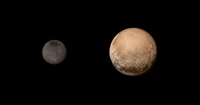
A telescopic image of Pluto and Charon.
The definition specifically excludes satellites from the category of dwarf planet, though it does not directly define the term "satellite". In the original draft proposal, an exception was made for Pluto and its largest satellite, Charon, which possess a barycenter outside the volume of either body. The initial proposal classified Pluto/Charon as a double planet, with the two objects orbiting the Sun in tandem. However, the final draft made clear that, double or not, both Pluto and Charon would be considered dwarf planets, not planets.
Under the same definition, the Earth-Moon system is not formally recognized as a double planet, despite the Moon's large relative size, since the barycenter lies within the Earth. As the Moon is slowly receding from the Earth, the Earth-Moon system may eventually become a double planet system on the basis of this barycentric definition.
Also, many moons, even those that do not orbit the Sun directly, often exhibit features in common with true planets. Jupiter's moon Ganymede and Saturn's moon Titan are both larger in terms of diameter (though not mass) than Mercury, and Titan even has a substantial atmosphere, thicker than the Earth's. Moons such as Io and Triton demonstrate obvious and ongoing geological activity, and Ganymede has a magnetic field.
It could be argued that, just as stars in orbit around other stars are still referred to as stars, thus objects in orbit around planets that share all their characteristics could also be called planets.
Extrasolar planets and brown dwarfs[]
- Main article: Extrasolar planet
The IAU's definition of planet applies only to objects within our own solar system. The more than 200 extrasolar planets (planet-sized objects in orbit around other stars) were excluded as too complex an issue to be resolved during the congress. However, any future definition will need to include them, as their discovery has widened the debate on the nature of planethood in unexpected ways. Many of these planets are of considerable size, approaching the mass of small stars, while many newly-discovered brown dwarfs are conversely small enough to be considered planets.[26]
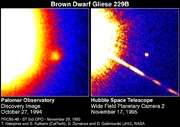
The brown dwarf Gliese 229B in orbit around its star.
Traditionally, the defining characteristic for starhood has been an object's ability to fuse hydrogen in its core. However, stars such as brown dwarfs have always challenged that distinction. Too small to commence sustained hydrogen fusion, they have been granted star status on their ability to fuse deuterium. However, due to the relative rarity of that isotope, this process lasts only a tiny fraction of the star's lifetime, and hence most brown dwarfs would have ceased fusion long before their discovery.[27] Binary stars and other multiple-star formations are common, and many brown dwarfs orbit other stars. Therefore, since they do not produce energy through fusion, they could be described as planets. Indeed, astronomer Adam Burrows of the University of Arizona claims that "from the theoretical perspective, however different their modes of formation, extrasolar giant planets and brown dwarfs are essentially the same."[28] Similarly, an orbiting white dwarf, such as Sirius B, since it too has ceased fusion, could be considered a planet. However, the current convention among astronomers is that any object massive enough to have possessed the capability to fuse during its lifetime should be considered a star.[29]
The confusion does not end with brown dwarfs. Maria Rosa Zapatario-Osorio et al. have discovered many objects in young star clusters of masses below that required to sustain fusion of any sort (currently calculated to be roughly 13 Jupiter masses).[30] These have been described as "free floating planets" because current theories of solar system formation suggest that planets may be ejected from solar systems altogether if their orbits become unstable. One could therefore argue that the original criterion that a planet must orbit a star should instead be amended to indicate that it must have originated in orbit around a star. This, however, would make large captured satellites such as Neptune's Triton into planets.
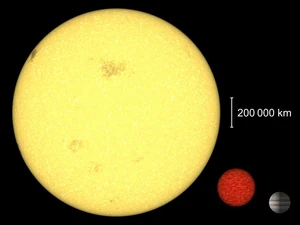
The solitary sub-brown dwarf Cha 110913-773444 (middle), the least massive brown dwarf yet found, set to scale against the Sun (left) and the planet Jupiter (right).
However, it is also possible that these "free floating planets" could have formed in the same manner as stars.[31] The material difference between a low-mass star and a large gas giant is not clearcut; apart from size and relative temperature, there is little to separate a gas giant like Jupiter from its host star. Both have similar overall compositions: hydrogen and helium, with trace levels of heavier elements in their atmospheres. The generally accepted difference is one of formation; stars are said to have formed from the "top down"; out of the gases in a nebula as they underwent gravitational collapse, and thus would be composed almost entirely of hydrogen and helium, while planets are said to have formed from the "bottom up"; from the accretion of dust and gas in orbit around the young star, and thus should have cores of silicates or ices.[32] As yet it is uncertain whether gas giants possess such cores. If it is indeed possible that a gas giant could form as a star does, then it raises the question of whether such an object, even one as familiar as Jupiter or Saturn, should be considered an orbiting low-mass star rather than a planet.
In 2003, the IAU officially released a statement[33] to define what constitutes an extrasolar planet and what constitutes an orbiting star. To date, it remains the only official decision reached by the IAU on this issue.
| “ |
|
” |
Like defining a "minor planet" by clearing its neighbourhood, this definition creates ambiguity by making location, rather than formation or composition, the determining characteristic for planethood. A free-floating object with a mass below 13 Jupiter masses is a "sub-brown dwarf," whereas such an object in orbit round a fusing star is a planet, even if, in all other respects, the two objects may be identical. This ambiguity was highlighted in December 2005, when the Spitzer Space Telescope observed Cha 110913-773444, the least massive brown dwarf yet found, only eight times Jupiter's mass with what appears to be the beginnings of its own star system. Were this object found in orbit round another star, it would have been termed a planet.[34]
Semantics[]
Finally, from a purely linguistic point of view, there is the dichotomy that the IAU created between 'planet' and 'dwarf planet'. The term 'dwarf planet' arguably contains two words, a noun and an adjective (dwarf). Thus, the term could suggest that a dwarf planet is a type of planet, even though the IAU explicitly defines a dwarf planet as not so being. Arguably, this can confuse people. This is met by the observation that, if so, the term 'minor planets' (which are also not planets) would share the same difficulties, although this term has been in use for many years, and that therefore 'dwarf planet' (and 'minor planet') is best considered as being a compound noun. Benjamin Zimmer, of languagelog.org, summarised the confusion: "The fact that the IAU would like us to think of dwarf planets as distinct from 'real' planets lumps the lexical item 'dwarf planet' in with such oddities as 'Welsh rabbit' [sic] (not really a rabbit) and 'Rocky Mountain oysters' (not really oysters)."[35] As Dava Sobel, historian and popular science writer who participated in the IAU's initial decision in October 2006, noted in an interview with National Public Radio, "A dwarf planet is not a planet, and in astronomy, there are dwarf stars, which are stars, and dwarf galaxies, which are galaxies, so ["dwarf planet" is] a term no one can love."[36]
See also[]
- 2006 redefinition of planet
- List of solar system objects by planetary discriminant
- Clearing the neighborhood
- Mesoplanet
- Controversy over Pluto's classification
- Natural kind
- Planemo
- Planetar
- Planetesimal
- Minor planet
- Dwarf planet
- Pluto prototype
- Definition of moon
Primary sources[]
- ↑ IAU Colloquia and Symposia sponsored by Division VIII (2006).
- ↑ Croswell, Ken (1999). Planet Quest: The Epic Discovery of Alien Solar Systems. Oxford University Press pp. 34-35 (ISBN 0-19-288083-7).
- ↑ Paul Schlyter. Appendix 7: Hypothetical Planets. nineplanets.org. Retrieved on 2006-10-04.
- ↑ 4.0 4.1 4.2 Hilton, James L.. When did asteroids become minor planets?. U.S. Naval Observatory. Retrieved on 2006-05-25.
- ↑ Weissman, Paul R.. The Kuiper Belt. Annual Review of Astronomy and Astrophysics. Retrieved on 2006-10-04.
- ↑ Brown, Mike.. A World on the Edge. NASA Solar System Exploration. Retrieved on 2006-05-25.
- ↑ The Status of Pluto:A clarification. International Astronomical Union, Press release (1999). Retrieved on 2006-05-25.
- ↑ Witzgall, Bonnie B. (1999). Saving Planet Pluto. Amateur Astronomer article. Retrieved on 2006-05-25.
- ↑ Brown, Mike (2006). The discovery of 2003 UB313, the 10th planet.. California Institute of Technology. Retrieved on 2006-05-25.
- ↑ M. E. Brown, C. A. Trujillo, and D. L. Rabinowitz (2005). DISCOVERY OF A PLANETARY-SIZED OBJECT IN THE SCATTERED KUIPER BELT. The American Astronomical Society.. Retrieved on 2006-08-15.
- ↑ McKee, Maggie (2006). Xena reignites a planet-sized debate. NewScientistSpace. Retrieved on 2006-05-25.
- ↑ Croswell, Ken (2006). The Tenth Planet's First Anniversary. Retrieved on 2006-05-25.
- ↑ Planet Definition. IAU (2006). Retrieved on 2006-08-14.
- ↑ IAU General Assembly Newspaper, 24 August 2006
- ↑ Definitions as voted on
- ↑ Robert Roy Britt (2006). Pluto demoted in highly controversial definition. Space.com. Retrieved on 2006-08-24.and[1]
- ↑ Pluto vote 'hijacked' in revolt.
- ↑ Stern, S. Alan, and Levison, Harold F. (2002). "Regarding the criteria for planethood and proposed planetary classification schemes" (PDF). Highlights of Astronomy 12: 205-213, as presented at the XXIVth General Assembly of the IAU - 2000 [Manchester, UK, 7 - 18 August 2000].
- ↑ Soter, Steven (2006-08-16). What is a Planet? (PDF). Retrieved on 2006-08-24. submitted to The Astronomical Journal, 16 August 2006
- ↑ Mark, Sykes (2006-09-08). Astronomers Prepare to Fight Pluto Demotion (RealPlayer). Retrieved on 2006-10-04.
- ↑ Brown, Michael E.. 2003EL61. California Institute of Technology. Retrieved on 2006-05-25.
- ↑ Calvert, J. V.. Mathematical Index: Ellipse. University of Denver. Retrieved on 2006-10-04.
- ↑ Thomas, P. C., Veverka, P., Helfenstein, P., Porco, C., Burns, J., Denk, T., Turtle, E., Jacobson, R. A. (2006). Shapes of the Saturnian icy satellites. 1Center for Radiophysics and Space Research, Cornell University,. Retrieved on 2006-06-10.
- ↑ Righter, Kevin; Drake, Michael J. (1997). A magma ocean on Vesta: Core formation and petrogenesis of eucrites and diogenites. METIC. Retrieved on 2006-05-25.
- ↑ Johanna Torppa, Mikko Kaasalainen, Tadeusz Michałowski, Tomasz Kwiatkowski, Agnieszka Kryszczyńska, Peter Denchev, and Richard Kowalski (2003). Shapes and rotational properties of thirty asteroids from photometric data. Astronomical Observatory, Adam Mickiewicz University,. Retrieved on 2006-05-25.
- ↑ IAU General Assembly: Definition of Planet debate (2006). Retrieved on 2006-24-09.
- ↑ Basri, Gibor. What is a planet?. Astronomy Dept., UC Berkeley. Retrieved on 2006-05-25.
- ↑ Burrows, Adam, Hubbard, W.B., Lunine, J., Leibert, James (2001). The Theory of Brown Dwarfs and Extrasolar Giant Planets. Department of Astronomy and Steward Observatory, and Lunar and Planetary Laboratory, The University of Arizona. Retrieved on 2006-06-09.
- ↑ Croswell, Ken (1999). Planet Quest: The Epic Discovery of Alien Solar Systems. Oxford University Press p. 119 (ISBN 0-19-288083-7).
- ↑ Zapatero M. R. Osorio, V. J. S. Béjar, E. L. Martín, R. Rebolo, D. Barrado y Navascués, C. A. L. Bailer-Jones, R. Mundt (2000). Discovery of Young, Isolated Planetary Mass Objects in the Sigma Orionis Star Cluster. Division of Geological and Planetary Sciences, California Institute of Technology. Retrieved on 2006-05-25.
- ↑ Rogue planet find makes astronomers ponder theory. Reuters (2000). Retrieved on 2006-05-25.
- ↑ G. Wuchterl (2004). Giant planet formation. Institut für Astronomie der Universität Wien. Retrieved on 2006-10-04.
- ↑ WORKING GROUP ON EXTRASOLAR PLANETS (WGESP) OF THE INTERNATIONAL ASTRONOMICAL UNION. IAU (2001). Retrieved on 2006-05-25.
- ↑ Clavin, Whitney (2005). A Planet With Planets? Spitzer Finds Cosmic Oddball. Spitzer Science Center. Retrieved on 2006-05-25.
- ↑ Nathan Bierma. New confusion as definition spins out of control. Chicago Tribune. Retrieved on 2006-10-04.
- ↑ A Travel Guide to the Solar System. National Public Radio (2006). Retrieved on 2006-11-18.
Secondary sources[]
- Q&A New planets proposal Wednesday, 16 August 2006, 13:36 GMT 14:36 UK
- David Jewitt's Kuiper Belt page- Pluto
- Dan Green's webpage: What is a planet?
- What is a Planet? Debate Forces New Definition
- The Flap Over Pluto
- "You Call That a Planet?: How astronomers decide whether a celestial body measures up."
- David Darling. The Universal Book of Astronomy, from the Andromeda Galaxy to the Zone of Avoidance. 2003. John Wiley & Sons Canada (ISBN 0-471-26569-1), p. 394
- Collins Dictionary of Astronomy, 2nd ed. 2000. HarperCollins Publishers (ISBN 0-00-710297-6), p. 312-4.
- Catalogue of Planetary Objects. Version 2006.0 O.V. Zakhozhay, V.A. Zakhozhay, Yu.N. Krugly, 2006
- The New Proposal, Resolution 5, 6 and 7 2006-08-22